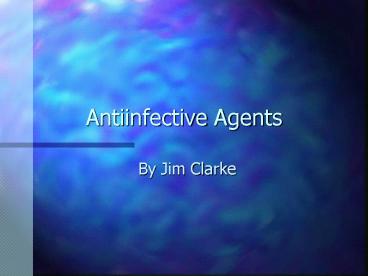Antiinfective Agents - PowerPoint PPT Presentation
1 / 36
Title:
Antiinfective Agents
Description:
Aerosol administration delivers drug to area of lung most likely to be affected ... Use gloves, mask & eyewear. Ribavirin. Classification ... – PowerPoint PPT presentation
Number of Views:1206
Avg rating:3.0/5.0
Title: Antiinfective Agents
1
Antiinfective Agents
- By Jim Clarke
2
Aerosolized Anti-infectives
- 2 occasionally used agents
- Pentamidine (NebuPent)
- Ribavirin (Virazole)
3
Indications for Pentamidine
- History of one or more episodes of PCP
- A low CD4 lymphocyte count
4
Rationale for Administration
- Aerosol administration delivers drug to area of
lung most likely to be affected - Parenteral administration has numerous side
effects - Aerosol administration produces higher blood
levels than parenteral
5
Side Effects of Aerosol Pentam
- Cough bronchial irritation
- SOB
- Bitter taste (burning in mouth)
- Bronchospasm wheezing
- Conjunctivitis
6
Dosing Issues
- Use nebulizer designed for Pentam use
- Should produce particles in 1-2 micron range
- Should have one-way valves directing exhalation
through filter - Give tx in negative pressure booth or room
7
Dosing Issues
- Pregnant or nursing mothers should avoid contact
- Use gloves, mask eyewear
8
Ribavirin
- Classification
- Anti-viral agent that works against RSV
(Respiratory Syncytial Virus), influenza herpes
simplex - Indications
- Given via inhalation to children suffering from
RSV - Only given if patient has severe bronchiolitis
with moderate to severe hypoxemia
9
Side Effects
- Pulmonary
- Deterioration of pulmonary function pneumothrax
bacterial infection - Cardiovascular
- Hypotension cardiac arrest
- Topical
- Rash eyelid erythema conjunctivitis
10
Dosing Issues
- Virazole must be given with SPAG nebulizer
- Generally given via head-hood
- Can be given via ventilator
11
Aerosolized Antibiotic Use
- In Cystic Fibrosis
- Has become a popular method for prevention of
pneumonia - Prevents outbreaks of Pseudomnas aeruginosa,
Hemophilus influenzae Staphylococcus aureus - Gentamicin
12
Non-Aerosolized Antibiotics
13
Definitions
- Antibiotic is a substance produced by
microorganisms that is capable of inhibiting or
killing bacteria and other microorganisms - Mode of Action - how the antibiotic actually
kills the targeted microorganisms
14
Antibiotic Terms
- Bacteriostatic- a drug that inhibits the growth
of a microorganism - Bactericidal is a drug that kills the
microorganism - Broad Spectrum - a drug that works on a wide
variety of organisms - Narrow Spectrum - a drug that works only only a
few organisms
15
How Antibiotics Work
16
Inhibition of Cell Wall Synthesis
- These antibiotics prevent normal cell wall
formation - Examples of these antibiotics
- Penicillans
- Bacitracin
- Cephalosporins
- Vancomycin
17
Alteration of Cell Membrane Permeability
- Disruption of cell wall filtering causes cellular
death - Examples
- Polymyxin B
18
Inhibition of Protein Synthesis
- Prevention of the ribosomes ability to make
necessary proteins - Examples
- Gentamicin
- Erthromycin
- Streptomycin
- Tetracyclines
19
Inhibition of Nucleic Acid Synthesis
- Prevents DNA replication or formation of
messenger RNA - Examples
- Cipro
- Trimethoprim
- Sulfonamides
- Rifampin
20
Antibiotic Sensitivity Resistance
- Sensitivity - measures how well the antibiotic
inhibits or kills - Resistance - describes an organisms ability to
inactivate the antibiotic
21
Penicillins
- Inhibit cell wall formation
- Numerous forms available - generic agents always
end with cillin - Numerous strains of Staph. Aureus, E. coli,
Proteus and pseudomonas species are resistant to
penicillans - Nafcillan is now the only agent that generally
works on Staph. Aureus - Penicillans used to treat Strep., some Staph and
Haemophilus influenzae infections
22
Cephalosporins
- Broken into 3 categories
- First generation - active on gram organisms
- Second generation - more active on gram -
organism - Third generation - variable against gram
more active against gram -
23
Cephalosporins cont.
- Nephrotoxicity can occur causing renal necrosis
24
Aminoglycosides
- Act by prevention of normal protein synthesis
- Used to treat many gram - pneumonias
- Examples
- Gentamicin, Tobramycin Amikacin
- Inhalation used in tx of Pseudomonas pneumonias
in Cystic Fibrosis - These agents can be extremely nephrotoxic
25
Tetracyclines
- Act by interfering with protein synthesis
- Broad spectrum
- Used to treat atypical pneumonias
- Mycoplasma pneumoniae
- Cause GI irritation nausea, diarrhea
- Should not be used with children except for short
periods - (tooth discoloration)
26
Fluoroquinolones
- Broad Spectrum
- Inhibition of DNA synthesis
- Used widely in COPD Cystic Fibrosis
- Pseudomonas Aeruginosa
- Examples
- Cipro (Ciprofloxacin)
- Noroxin (Norfloxacin_
27
Macrolides (Etythromycins)
- Inhibit protein synthesis
- Drug of choice for treatment of Mycoplasma
Legionella infections - Oral administration can cause GI upset
- Examples
- Biaxin
- Zithromax
28
Sulfonamides
- Inhibit nucleic acid synthesis
- Not really an antibiotic!
- Used mainly to treat urinary some intestinal
infections - Trimethoprim-Sulfamethoxazole combination used to
treat Pneumocystis carinii pneumonia
29
Miscellaneous Antibiotics
30
Vancomycin
- Reserved mainly for use in treating
methicillin-resistant S. aureus (MRSA) - Can be toxic to the kidneys ears
- There are now strains of Enterobacter that are
resistant to Vancomycin (VRE)
31
Chloramphenicol
- Very rarely used due to chances of causing
aplastic anemia - Only used in cases of life-threatening infections
resistant to other antibiotics
32
Flagyl
- Used as an antiprotozoal agent to treat GI
infections most anaerobes
33
Nitrofurantoin (Furadantin)
- Synthetic agent (not a true antibiotic)
- Broad Spectrum agent
- Used mainly in tx of urinary tract infections
- Can cause pulmonary side effects
- pleural effusions and infiltrates
34
Antifungal Agents
- Amphotericin B
- Has severe toxic side effects - nephrotoxicity
fever decreased BP - Can cause metabolic acidosis!
- Nystatin
- Topical treatment for Candida albicans infections
35
Anti-Tuberculosis Drugs
36
End of this session































